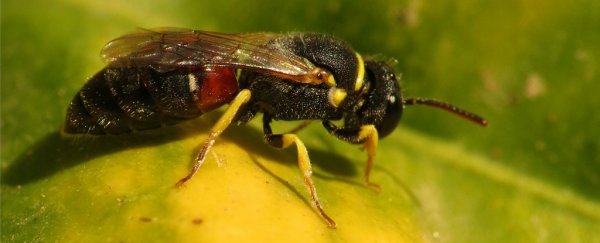The US government has announced that seven species of Hawaiian yellow-faced bees have officially been added to the endangered species list, which means they're now the first US bee species to earn federal protection under the Endangered Species Act.
The US Fish and Wildlife Service's decision will hopefully put in place systems that will help these affected populations rebound, saving some of the state's biggest pollinators from extinction.
"Native pollinators in the US provide essential pollination services to agriculture which are valued at more than US $9 billion annually," Eric Lee-Mäder, program director at the Xerces Society, the non-profit organisation that petitioned the US government to label the bees as endangered, told CNN.
The seven species – Hylaeus anthracinus, Hylaeus longiceps, Hylaeus assimulans, Hylaeus facilis, Hylaeus hilaris, Hylaeus kuakea, and Hylaeus mana – live in many different habitats on the Hawaiian Islands, such as coastlines, wet and dry forests, and shrublands.
But what they all have in common is that their numbers are dwindling.
"These bees require a habitat with a diversity of plants that flower throughout the year so that a consistent source of pollen and nectar is available," the Xerces Society reports.
"Many species nest in the ground, but some nest in hollow stems of plants; the availability of nest sites is another important habitat requirement for these animals."
The team says the bees are threatened mostly by human development and invasive species, both of which are causing them to lose vital habitat, prompting populations to become splintered and sparse.
While so far only Hawaiian bees have been added to the list, just last week, the US Fish and Wildlife Service also proposed adding the rusty patched bumble bee – a dwindling species that was once common in the upper midwest and north-eastern United States – so we could see more mainland species added in years to come.
The plight of bees across the world has been making headlines a lot lately, largely because bees are one of the world's greatest pollinators. Without them, roughly 30 percent of the world's crops and 90 percent of our wild plants would fail.
"People tend to focus on the rare plants, and those are important, that's a big part of the diversity," Xerces entomologist Karl Magnacca told the AP. "But the other side is maintaining the common ones as common. [The bees] help maintain the structure of the whole forest."
To save the seven species, programs will need to be put in place that allows their populations to thrive. This hopefully means federal agencies will fund efforts to protect the areas of Hawaii where known populations live, though an exact plan has yet to surface.
While the news marks the first time that the US government has added any bee species to the endangered species list, it isn't the first time bees have been talked about by policy makers.
Back in 2015, the White House issued a report entitled, "National Strategy to Promote the Health of Honey Bees and Other Pollinators", which aimed to come up with a system to protect bees and butterflies.
This initial strategy was prompted after reports surfaced that 'colony collapse disorder' (CCD), which occurs when most of the worker bees suddenly leave the hive, abandoning their queen, was becoming widespread.
At the time, CCD was causing roughly 20 to 40 percent of honeybee colonies in the mainland US to vanish every winter, reports Christopher Ingraham for The Washington Post.
The fact that seven new bee species have now been added to the endangered species list will hopefully further the cause, and remind everyone just how important these pollinators are.

